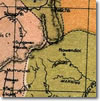|
The first waterside workers' unions in Australia were formed in Port Adelaide, Sydney, and Port Melbourne in 1872. By 1889 there were notable waterfront unions in New South Wales, South Australia, Victoria and Western Australia. The various unions federated in March 1890 but the Waterside Workers' Federation of Australia [WWF] was not established until 7 February 1902. Following Federation it was believed that state and port based unions would have common concerns which could be more adequately addressed by a federal body. Subsequently, the state wharf labourers' organisations met to discuss the formation of a federal body and established a Committee which included 5 members of Parliament, two of whom later became Prime Minister of Australia (Andrew Fisher and Billy Hughes). In 1902 the WWF was formed with Sydney Branch Secretary, W.M. Hughes elected as the organisation's first President. Other inaugural members included F.W. Bamford (Vice President), Senator de Largie (Treasurer) and Joe Morris (Secretary). By the end of 1902 the WWF consisted of 18 branches and 6260 members. Following many debates within the ranks of the union the WWF applied for and obtained federal registration as a union in 1907, and elected Billy Hughes as its first General President, a position he maintained until 1916 when he was expelled from the union for his views on conscription. The structure of the WWF remained largely unchanged until 1950 when it absorbed the Permanent & Casual Wharf Labourers Union of Australia. In 1991 the WWF amalgamated with the Australian Foremen Stevedore Association but retained the name Waterside Workers' Federation of Australia. The largest change to the administrative structure of the WWF occurred when it amalgamated with the Seamen's Union of Australia [SUA] in 1993 to form the Maritime Union of Australia [MUA]. Whilst joint General Secretaries controlled the MUA under the new structure, they ensured that the representation and responsibilities of the former Waterside Workers and the Seamen were differentiated. The MUA dispute in 1998 did, however, consolidate the MUA as a single union.
|

